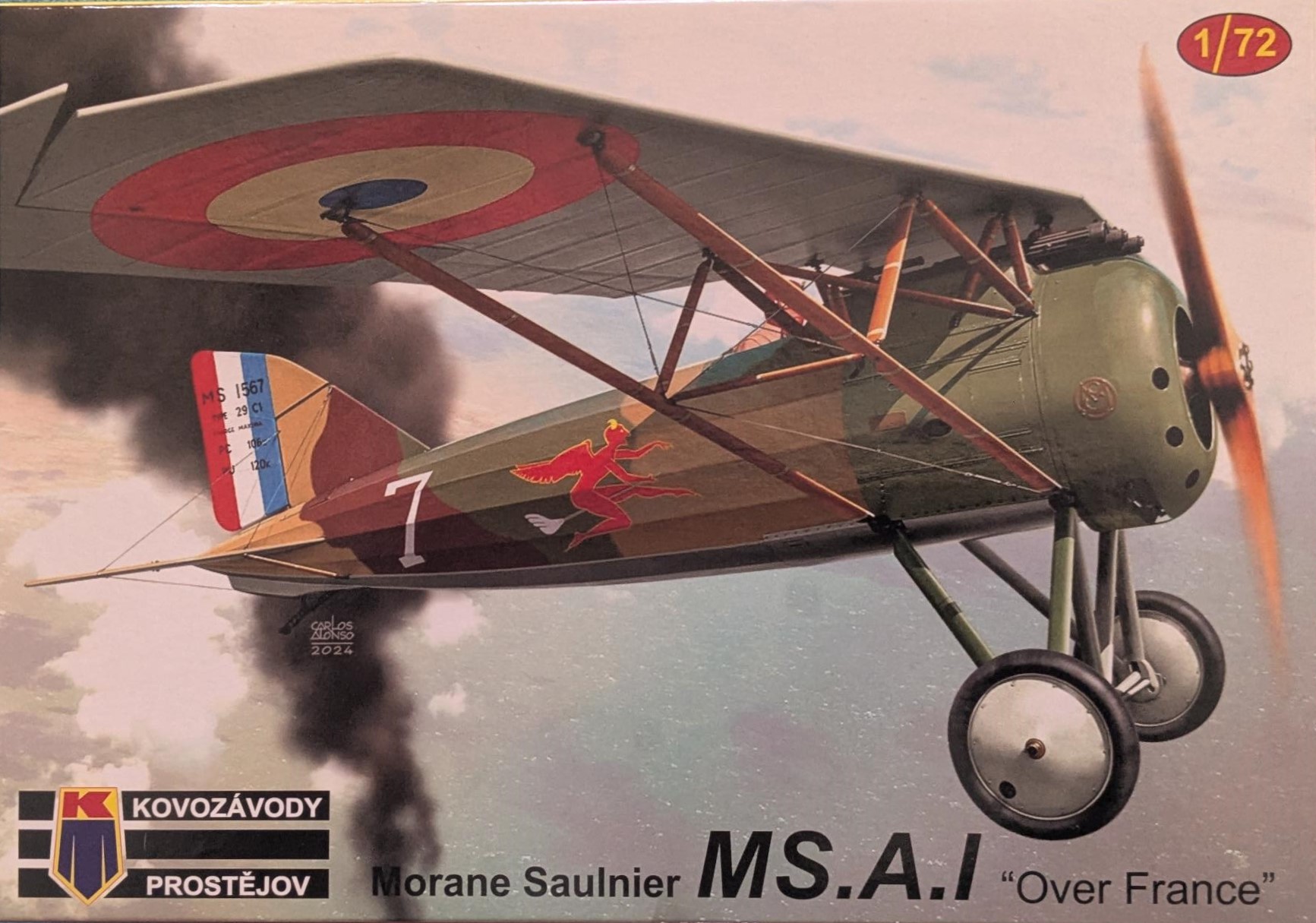Morane Saulnier MS.A.I. "Over France"
From the Kovozávody Prostějov instructions,
Morane-Saulnier MS.A.1 (also Type A1) was a French parasol-wing fighter aircraft produced by Morane-Saulnier during World War I. A number of escadrilles were created to operate the AI, but by mid-May 1918, most of the aircraft were replaced by the SPAD XIII. After structural problems had been resolved, the aircraft were then relegated to use as advanced trainers, with new purpose built examples being designated MoS 30. Many were used post-war after having been surplussed off, as aerobatic aircraft, including one which was flown by Charles Nungesser.
I have long respected WWI era plane modelers. I respect 1/72 WWI era plane modelers even more. And now, I question my sanity after tackling this one. This is not a kit for a novice or even an uninterested intermediate modeler. With the right skill set and some other kits under your belt, and you want a Morane-Saulnier MS.A.1, then this is the only injection molded option available.
This Czech Republic model comes in a side opening box containing one large sprue and a decal sheet. The instructions come as a single folded black and white A4 sheet. Take care with small pieces (struts, control stick, etc) as the plastic is fragile and can break when removed from the sprue gates.
There are minor notes that are identified here by their instruction step:
Sprue Layout: No numbers on the parts trees, so use the layout as the parts number guide.
Step 1: Part No. 15 – dry fit for the proper orientation as the thin side goes forward, sink mark underneath.
Step 2: Parts Nos. 20 and 32 are shown upside down. Use the small locating holes in each as the guide for the horizontal elevator struts (Parts No. 5, Step 3).
Steps 3 and 4: Swap order as Step 3 is easier to assemble the struts before landing gear. Also, two of the sub-steps show the struts already assembled (Step 4) and have additional bracing attaching to these parts.
Step 4 (3): Align the wing bottom surface locating holes to the struts while glueing for proper alignment.
Step 3: The landing gear main horizontal strut (Part No. 26) is too long. Study the kit box for proper alignment and cut to proper length accordingly.
Step 5:
- Part No. 33 does not look as it does in the instructions and is rather a quarter moon-shaped cover for the bottom of the engine.
- The pin part does not exist; the propeller shaft (Part No. 19) fits into the radial engine (Part No. 14)
Step 6: Attach the wing to the struts contact pieces – good luck!
The box art provides painting and decal guides for three French Morane Saulnier MS.A.I aircraft:
- MS.A.1, 7, 1567, French Air Force, 1918
- MS.A.1, 3, 1724, French Air Force, 1918
- MS.A.1, 11, 1591, French Air Force, 1918
I chose the first option as it has a red devil flying a broom. Ironically, the instructions provide a color callout, but no reference to the colors in the instructions or the box art (which has basic color callouts with no specific nomenclature). Think through the painting on this aircraft as the struts and fragile parts complicate a straightforward build, then paint approach (this also applies to the decals). I built the aircraft, leaving the top wing off until final assembly after painting and decaling.
The decals are very delicate and initially conformed well to the model with just water. To be clear, that was my initial impression as several decals shattered and pulled apart as they were drying. I used Tamiya Mark Fit and that also initially helped. The decals then set properly, except for the top wing roundels, which bubbled. After the decals dried, I lightly sanded the bubbles and did some touch-up painting.
There are also no rigging instructions or diagrams to make this requisite step a reality. The modeler will have to research on their own, but fortunately, rigging is at a minimum with this aircraft.
A few things to make this kit easier would be to include masks or scale size painting guide to make the lines clean and correct in shape. Alas, no pilot figure is included, which makes it hard for an in-flight model.
If you want a unique WWI aircraft, then KP Models has you covered. There are three other boxings for the French Morane Saulnier MS.A.I models that appear to have the same base kit with different decal options:
- Morane Saulnier MS.A.1 “French Services” with two civil and one combat markings
- Morane Saulnier MS.A.1 “Other Services” with Belgium, Swiss and Japanese markings
- Morane Saulnier MoS.30 (A.1.) “Polish Services” with three different Polish markings
In the hands of experienced small-scale biplane modelers, this will build into an amazing kit and fills a gap in WWI aircraft.
Profuse thanks to Kovozávody Prostějov and IPMS/USA for providing the review sample.












Comments
Add new comment
This site is protected by reCAPTCHA and the Google Privacy Policy and Terms of Service apply.
Similar Reviews